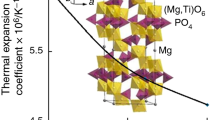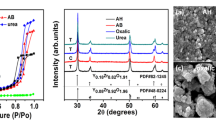Abstract
The ZrO2–8 wt% Y2O3 (8YSZ) nanopowders were prepared by sol–gel process using acetic acid (AcOH) as hydrolyst and chelating agent in the water–ethanol solution. The effects of AcOH and ethanol on the phase structure and morphological characteristic of 8YSZ nanopowders were investigated by X-ray diffraction, scanning electron microscopy and transmission electron microscopy. Based on these results, the crystal growth behavior of 8YSZ nanopowders was discussed. The results indicate that the addition of ethanol in solvent is not beneficial for the stability of tetragonal phase. However, the stable tetragonal phase in 8YSZ powders can be obtained with water as solvent and the molar ratio AcOH/Zr equal to 1:1. The crystallite size increases with the heat-treatment temperature increasing. In addition, the activation energy for crystal growth in low heat-treatment temperatures is much lower than that in higher heat-treatment temperatures due to the different growth mechanisms.












Similar content being viewed by others
References
Xu ZH, He SM, He LM, Mu RD, Huang GH, Cao XQ (2011) Novel thermal barrier coatings based on La2(Zr0.7Ce0.3)2O7/8YSZ double-ceramic-layer systems deposited by electron beam physical vapor deposition. J Alloys Compd 509:4273–4283
Keyvani A, Saremi M, Heydarzadeh Sohi M, Valefi Z (2012) A comparison on thermomechanical properties of plasma-sprayed conventional and nanostructured YSZ TBC coatings in thermal cycling. J Alloys Compd 541:488–494
Farhikhteh S, Maghsoudipour A, Raissi B (2010) Synthesis of nanocrystalline YSZ (ZrO2–8Y2O3) powder by polymerized complex method. J Alloys Compd 491:402–405
Schindler K, Schmeisser D, Vohrer U, Wiemhöfer HD, Göpel W (1989) Spectroscopic and electrical studies of yttria-stabilized zirconia for oxygen sensors. Sens Actuators 17:555–568
Rodrigues CMS, Labrincha JA, Marques FMB (2000) Postmortem characterization of one yttria stabilized zirconia (YSZ)-based oxygen sensor. Solid State Ion 136–137:671–675
Jia L, Lü Z, Huang XQ, Liu ZG, Chen KF, Sha XQ, Li GQ, Su WH (2006) Preparation of YSZ film by EPD and its application in SOFCs. J Alloys Compd 424:299–303
Zhang C, Li CJ, Liao HL, Planche MP, Li CX, Coddet C (2008) Effect of in-flight particle velocity on the performance of plasma-sprayed YSZ electrolyte coating for solid oxide fuel cells. Surf Coat Technol 202:2654–2660
Scott HG (1975) Phase relationships in the zirconia–yttria system. J Mater Sci 10:1527–1535
Viazzi C, Bonino JP, Ansart F, Barnabé A (2008) Structural study of metastable tetragonal YSZ powders produced via a sol–gel route. J Alloys Compd 452:377–383
Shi JL, Ruan ML, Yen TS (1996) Crystallite growth in yttria-doped superfine zirconia powders and their compacts: a comparison between Y-TZP and YSZ. Ceram Int 22:137–142
Aruna ST, Balaji N, Prakash BS (2011) Low temperature assisted chemical coprecipitation synthesis of 8YSZ plasma sprayable powder for solid oxide fuel cells. Int J Hydrogen Energy 36:14963–14970
Khollam YB, Deshpande AS, Patil AJ, Potdar HS, Deshpande SB, Date SK (2001) Synthesis of yttria stabilized cubic zirconia (YSZ) powders by microwave-hydrothermal route. Mater Chem Phys 71:235–241
Gonzalo-Juan I, Ferrari B, Colomer MT (2009) Influence of the urea content on the YSZ hydrothermal synthesis under dilute conditions and its role as dispersant agent in the post-reaction medium. J Eur Ceram Soc 29:3185–3195
Suciu C, Hoffmann AC, Vik A, Goga F (2008) Effect of calcination conditions and precursor proportions on the properties of YSZ nanoparticles obtained by modified sol–gel route. Chem Eng J 138:608–615
Mamana N, Díaz-Parralejo A, Ortiz AL, Sánchez-Bajo F (2014) Influence of the synthesis process on the features of Y2O3-stabilized ZrO2 powders obtained by the sol–gel method. Ceram Int 40:6421–6426
Suciu C, Hoffmann AC, Kosinski P (2008) Obtaining YSZ nanoparticles by the sol–gel method with sucrose and pectin as organic precursors. J Mater Process Technol 202:316–320
Lee YH, Kuo CW, Hung IM, Fung KZ, Wang MC (2005) The thermal behavior of 8 mol% yttria-stabilized zirconia nanocrystallites prepared by a sol–gel process. J Non-Cryst Solids 351:3709–3715
Feng JZ, Feng J, Zhang CR (2011) Shrinkage and pore structure in preparation of carbon aerogels. J Sol-Gel Sci Technol 59:371–380
Zou CR, Zhang CR, Li B, Cao F, Wang SQ (2012) Improved properties and microstructure of porous silicon nitride/silicon oxide composites prepared by sol–gel route. Mater Sci Eng A 556:648–652
Yan CL, Liu RJ, Cao YB, Zhang CR, Zhang DK (2012) Synthesis of submicrometer zirconium carbide formed from inorganic–organic hybrid precursor pyrolysis. J Sol-Gel Sci Technol 64:251–256
Liu DQ, Cheng HF, Zheng WW, Zhang CY (2012) Infrared thermochromic properties of VO2 thin films prepared through aqueous sol–gel process. J Wuhan Univ Technol-Mater Sci Ed 27:861–865
Rajath Varma PC, Colreavy J, Cassidy J, Oubaha M, Duffy B, McDonagh C (2009) Effect of organic chelates on the performance of hybrid sol–gel coated AA 2024-T3 aluminium alloys. Prog Org Coat 66:406–411
Viazzi C, Deboni A, Ferreira JZ, Bonino JP, Ansart F (2006) Synthesis of yttria stabilized zirconia by sol–gel route: influence of experimental parameters and large scale production. Solid State Sci 8:1023–1028
Chen HI, Chang HY (2004) Homogeneous precipitation of cerium dioxide nanoparticles in alcohol/water mixed solvents. Colloids Surf A 242:61–69
Li W, Gao L (2001) Nano ZrO2 (Y2O3) particles processing by heating of ethanol–aqueous salt solutions. Ceram Int 27:543–546
Moon J, Choi H, Kim H, Lee C (2002) The effects of heat treatment on the phase transformation behavior of plasma-sprayed stabilized ZrO2 coatings. Surf Coat Technol 155:1–10
Shukla S, Seal S, Vij R, Bandyopadhyay S (2003) Reduced activation energy for grain growth in nanocrystalline yttria-stabilized zirconia. Nano Lett 3:397–401
Huang WZ, Yang JL, Meng XS, Cheng YL, Wang CJ, Zou BL, Khan Z, Wang Z, Cao XQ (2011) Effect of the organic additions on crystal growth behavior of ZrO2 nanocrystals prepared via sol–gel process. Chem Eng J 168:1360–1368
Wang Y, Cheng HF, Liu HT, Wang J (2013) Microstructure and room temperature mechanical properties of mullite fibers after heat-treatment at elevated temperatures. Mater Sci Eng, A 578:287–293
Hassanzadeh-Tabrizi SA, Mazaheri M, Aminzare M, Sadrnezhaad SK (2010) Reverse precipitation synthesis and characterization of CeO2 nanopowder. J Alloys Compd 491:499–502
Štefanić G, Štefanić II, Musić S (2000) Influence of the synthesis conditions on the properties of hydrous zirconia and the stability of low-temperature t-ZrO2. Mater Chem Phys 65:197–207
Štefanić G, Musić S, Greta B, Popović S, Sekulić A (1998) XRD and laser Raman spectroscopy investigation of the stability of low temperature t-ZrO2. Croat Chem Acta 71:789–806
Afanasiev P, Geantet C, Breysse M (1994) Role of oxoanions in the stabilization of tetragonal zirconia. J Mater Chem 4:1653–1657
Štefanić G, Musić S, Popović S, Sekulić A (1997) FT-IR and laser Raman spectroscopic investigation of the formation and stability of low temperature t-ZrO2. J Mol Struct 408(409):391–394
Huang WZ, Yang JL, Wang CJ, Zou BL, Meng XS, Wang Y, Cao XQ, Wang Z (2012) Effects of Zr/Ce molar ratio and water content on thermal stability and structure of ZrO2–CeO2 mixed oxides prepared via sol–gel process. Mater Res Bull 47:2349–2356
Graham Solomons TW, Fryhle CB (2011) Organic chemistry, 10th edn. Wiley Inc, New York, pp 797–798
Li JG, Ikegami T, Lee JH, Mori T (2001) Characterization and sintering of nanocrystalline CeO2 powders synthesized by a mimic alkoxide method. Acta Mater 49:419–426
Lai TL, Shu YY, Huang GL, Lee CC, Wang CB (2008) Microwave-assisted and liquid oxidation combination techniques for the preparation of nickel oxide nanoparticles. J Alloys Compd 450:318–322
Kuo CW, Shen YH, Hung IM, Wen SB, Lee HE, Wang MC (2009) Effect of Y2O3 addition on the crystal growth and sintering behavior of YSZ nanopowders prepared by a sol–gel process. J Alloys Compd 472:186–193
Nieh TG, Wadsworth J (1990) Superelastic behavior of a fine-grained, yttria-stabilized, tetragonal zirconia polycrystal (Y-TZP). Acta Metall Mater 38:1121–1133
Zhou XD, Huebner W (2001) Size-induced lattice relaxation in CeO2 nanoparticles. Appl Phys Lett 79:3512–3514
Yao WH, Tang ZL, Zhang ZT, Luo SH (2002) Preparation of 8 mol% yttria-stabilized zirconia by an oil flotation-assisted chemical coprecipitation route. Mater Lett 57:502–506
Acknowledgments
This work was financially supported by the Aid program for Science and Technology Innovative Research Team in Higher Educational Institutions of Hunan Province and Aid Program for Innovative Group of National University of Defense Technology.
Author information
Authors and Affiliations
Corresponding authors
Rights and permissions
About this article
Cite this article
Huang, Q., Yuan, W., Huang, W. et al. Effect of organic additions on the phase composition and crystal growth behavior of 8 wt% yttria-stabilized zirconia nanocrystals prepared via sol–gel process. J Sol-Gel Sci Technol 74, 432–446 (2015). https://doi.org/10.1007/s10971-015-3619-2
Received:
Accepted:
Published:
Issue Date:
DOI: https://doi.org/10.1007/s10971-015-3619-2




